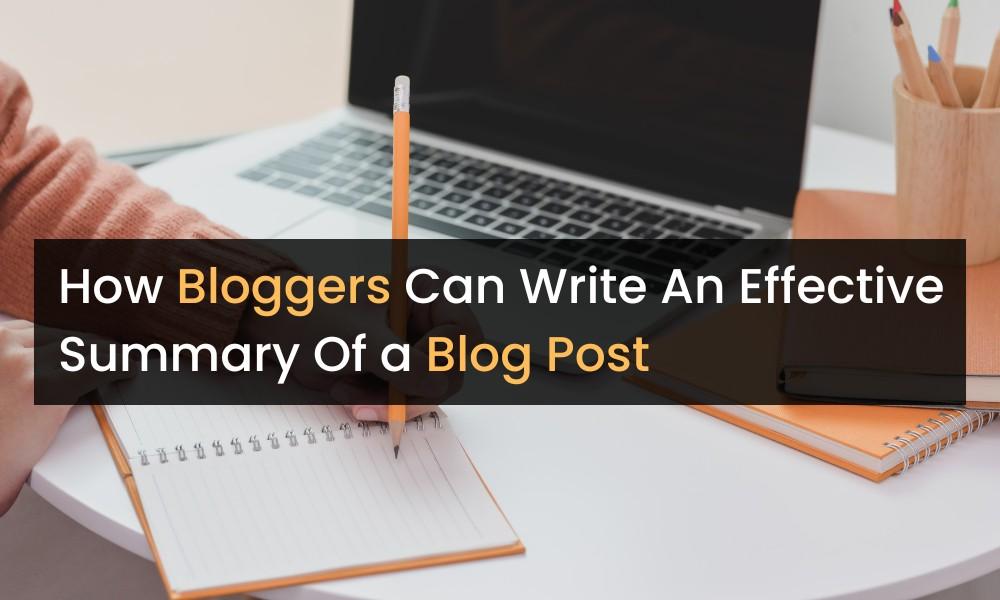In this rapidly developing world, no one has time to read lengthy articles and blog posts. Especially, when they are not sure about the content of the article. However, a table of contents can help in overviewing the headings in the content. But the main essence that can make a reader forced to read the whole content is the content summary.
A good blog post lies between 1000 to 1500 words. Reading the whole blog post to see whether it has something relevant to your requirement or not can be hectic. Hence, a summary can assist a reader to decide whether to give it a read or not.
But, writing an effective summary is not a child’s play. It is a technical part of a blog post that can attract or offend any reader that comes to your article. Hence, a professionally written blog summary can make an impact for sure.
What is an Effective Summary?
A blog generally contains thousands of words in support of an argument. Which can take a healthy time to read, but prior to reading the whole blog, it is more viable to read the summary first. Because an effective summary contains the crux of a whole blog post. In other words, an effective summary is a brief definition of arguments discussed in the blog post.
Are you a blogger and struggling to write effective summaries of your blog posts? Congratulations! you are in the right place. Here in this post, we will discuss the ways a blogger can effectively write blog summaries.
How to Write an Effective Blog Summary?
Here are a few tips in support of writing an effective and efficient blog summary that works for you. Stay tuned and read till the end!
Ø Read and Repeat
After writing the whole blog post, it’s time to read it thoroughly. If you had written the blog post by yourself, you will have an in-depth knowledge of what you have written. But if someone wrote it for your blog then you have to give it a read multiple time.
Understanding the depth and context of a blog is very important before writing its summary. Because without a proper concept you cannot write an effective summary. So, the first tip is to read and read again before writing.
Ø Point Out the Punch Lines
By reading the blog post again and again, you will come to know the crux of it. A good blog post will definitely have a few punch lines that make the users think. You have to pick up those punch lines or arguments and add them to your summary.
Also, take those important points that you feel can make the reader take some action. For example, call to action like; do follow, implement these tips, don’t forget to comment, etc. Extracting the important points will help you in writing the summary more effectively.
Ø Write The Extracted
Taking notes on a notepad can be very helpful in writing an effective content summary. While extracting the punch lines and important points from the blog, do write them down. Because there is always a possibility of forgetting.
Notes can also help in writing summaries more swiftly. They will never let you forget any important point. It also keeps your mind engaged while drafting a summary of your blog post.
Ø Draft Your First Attempt
After extracting the important point and taking notes, it is time to write your first draft. Do not post a blog summary instantly after writing it, instead write it as a draft first. Because as humans we can make a lot of grammatical, spelling, and punctuation mistakes.
There should be no errors or omissions in the posted summary. Hence, a draft can help eliminate mistakes. Moreover, it can also help you in thinking out of the box or adding something that you haven’t considered yet.
Ø Entrap the Reader
Trapping the reader in the summary is an essential part you should always consider. This can be done by using hooks in the summary. Asking questions that make the user think is the best way to create a hook.
A hook can be call-to-action words or phrases that emphasize a point in the body of a blog post. Talking specifically, a hook refers the readers to some important part of a blog.
Ø Try to Keep It Concise
Avoid content stuffing in your blog summary. No matter how vast and long your blog post is, your blog summary should be concise. A five to six sentences summary is considered a good one.
Long summaries kill the purpose of writing a summary. Why would someone read a summary as lengthy as a short blog post? After all, summaries are meant to decrease the effort of reading full-length content.
Ø Be Clear & Direct
A concise summary won’t let you discuss irrelevant, unclear, and indirect matters in it. And if you still do so, the summary will not remain concise. Hence, never discuss or add such things in your blog summary that is not directly related to the context.
Do not make things complicated and confusing. Be clear and direct in presenting your perspective. Remember the summary is something that ends a blog post but not begins. Give your final verdict or suggestion at the end of a blog summary.
Ø Use AI Technology
If you find the above ways difficult or do not have time to write summaries manually, a summary generator can help you a lot. AI technology is meant to make people’s life easier by performing their day-to-day tasks. So, why not take advantage of it?

A summary generator can help you summarize the whole blog for you within a few seconds by using artificial intelligence algorithms. Moreover, some summary generators also support summarizing in different languages. Plus, provides grammatically correct and error-free results.
Ø Proofread
Proofreading is another practice that can help you a lot in making your blog’s summary more effective. You can ask some of your friends or family member with a good grip on language to proofread the whole summary for you.
This will help to overcome your flaws and makes you a better writer next time. Moreover, it saves you from errors and helps you make the summary sounder and louder.
Summary
Here to make your blog post summary better? Don’t worry we are not going to disappoint you.
In this article, the best ways to write an effective blog summary are discussed. We have covered almost every aspect of writing a blog summary, from the definition of summary to proofreading.
In between, you will also find tips to enhance the pitch and quality of your blog summary. So, what are your waiting for? Go give it a read.






